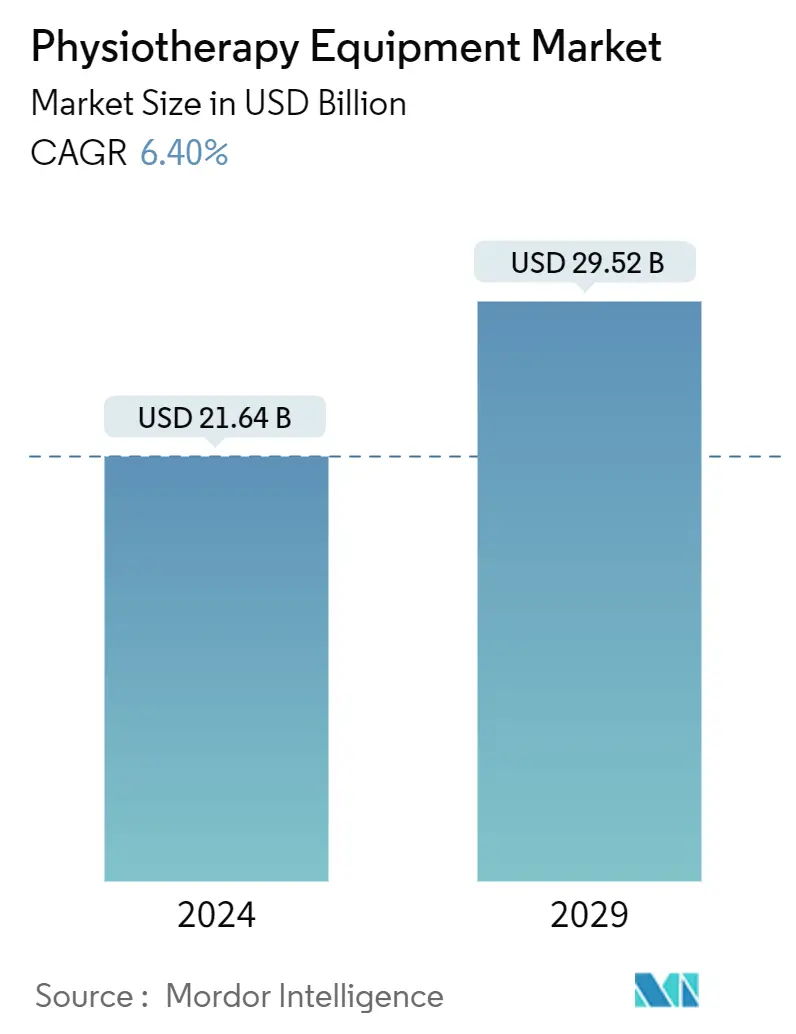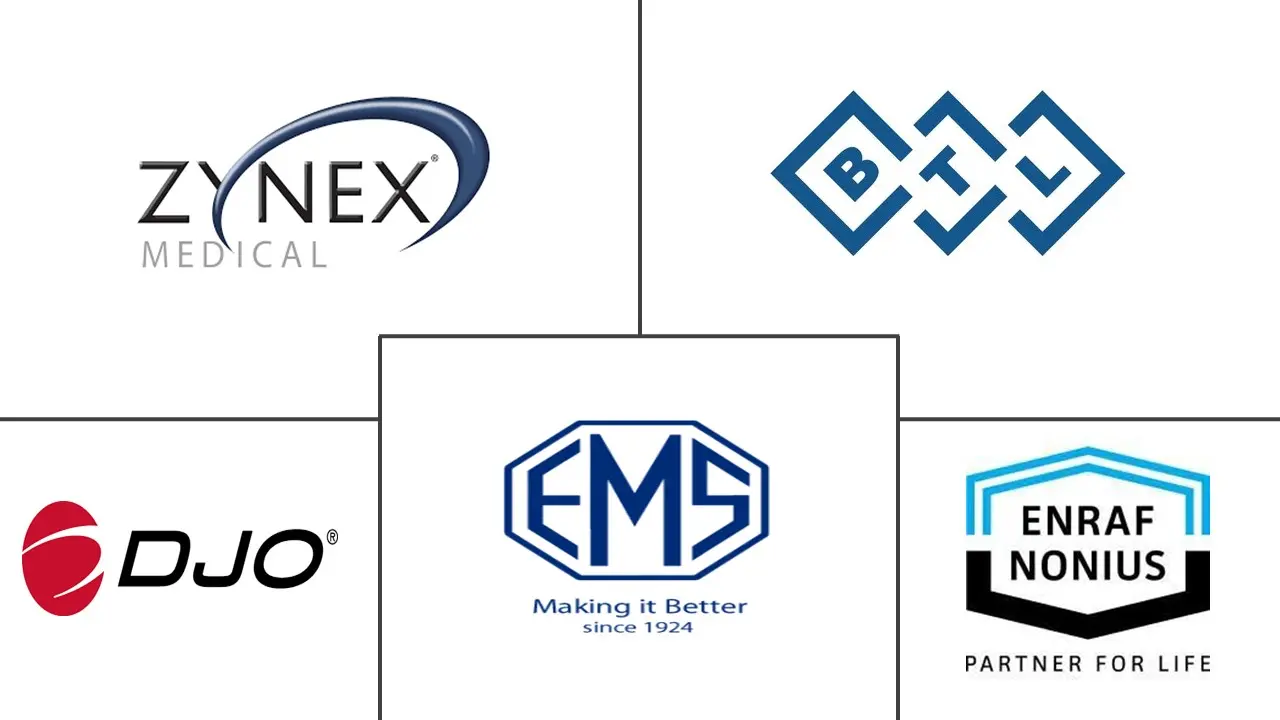Market Size of Physiotherapy Equipment Industry

| Study Period | 2019 - 2029 |
| Market Size (2024) | USD 21.64 Billion |
| Market Size (2029) | USD 29.52 Billion |
| CAGR (2024 - 2029) | 6.40 % |
| Fastest Growing Market | Asia-Pacific |
| Largest Market | North America |
Major Players
*Disclaimer: Major Players sorted in no particular order |
Physiotherapy Equipment Market Analysis
The Physiotherapy Equipment Market size is estimated at USD 21.64 billion in 2024, and is expected to reach USD 29.52 billion by 2029, growing at a CAGR of 6.40% during the forecast period (2024-2029).
COVID-19 impacted the studied market owing to the reduction in physiotherapy clinic visits and supply chain disruptions of the equipment. For instance, an article published in Work Journal in 2022 stated that out of the total surveyed physiotherapists, 62.9% suspended their services while 37% of all participants worked without suspending their services during the pandemic. Also, clinics and home visits of physiotherapists were suspended during the pandemic. Therefore, due to the high chances of physical contact among physiotherapists, equipment, and patients, leading to COVID-19 transmission, the physiotherapy equipment market slightly declined during the pandemic. However, the market recovered in the last few years due to the increasing use of physiotherapy equipment for COVID-19, musculoskeletal, and other diseases requiring physiotherapy for movement and other daily activities.
The increasing incidence of cardiovascular, musculoskeletal, and neurological disorders and the increasing demand for rehabilitation after surgeries, chemotherapy, and radiation are expected to stimulate the demand for physiotherapy equipment worldwide.
The musculoskeletal disorder leads to restricted mobility and is a major contributor to disability. For instance, according to the article published in the Annals of Medicine and Surgery in December 2021, the prevalence of work-related musculoskeletal disorders among the surveyed participants of North West Ethiopia was 64.2%. Additionally, according to Work-Related Musculoskeletal Disorders statistics, around 470 thousand people suffered from work-related musculoskeletal disorders which were new or long-standing in Great Britain, in 2021. Therefore, the high burden of musculoskeletal disorders and arthritis is expected to increase the need for physiotherapy equipment, thereby accelerating market growth.
Furthermore, the increasing burden of neurological disorders among the population is the major factor driving the demand for physiotherapy equipment for neurology rehabilitation. For instance, an article published in July 2022 in the International Journal of Environmental Research and Public Health stated that the most used physiotherapy procedures in elderly with neurological disorders are balance and gait training, occupational therapy, classical physiotherapy, walking and treadmill training, and upper limb robot-assisted therapy. Also, according to a WHO article published in March 2023, over 55 million people have dementia worldwide currently. As per the same source, nearly 10 million new cases are diagnosed every year. The high burden of dementia and other neurological diseases is expected to boost the demand for physiotherapy equipment to promote physical activity.
The strategic initiatives adopted by market players such as product launches and acquisitions significantly contribute to market growth. For instance, in April 2021, the National Office of Thermalism and Hydrotherapy (ONTH) launched one of the first mobile applications on hydrotherapy 'Tunisia Wellness'. Such launches boost the utility of physiotherapy equipment, thereby accelerating market growth.
Therefore, owing to the aforementioned factors such as the high burden of musculoskeletal and neurological conditions and rising product launches and acquisitions by market players, the studied market is anticipated to witness growth over the analysis period. However, the lack of trained and skilled personnel and inadequate reimbursement policies is estimated to restrain the market growth.
Physiotherapy Equipment Industry Segmentation
As per the scope of the report, physiotherapy encompasses various procedures, which utilize therapeutic exercises and physical modalities. It is aimed at the preservation, enhancement, or restoration of physical function impaired by disease, injury, or disability. The physiotherapy equipment market report covers medical devices, such as multi-exercise therapy units, heat therapy equipment, and laser therapy units, among others. The Physiotherapy Equipment Market is Segmented by Equipment Type (Hydrotherapy, Electrotherapy, Continuous Passive Motion Units, Multi-exercise Therapy Unit, Heat Therapy, Ultrasound, and Other Equipment Types), Application (Cardiovascular and Pulmonary, Neurological, Musculoskeletal, and Other Applications), End User (Hospitals, Rehabilitation Centers/Clinics, and Other End Users), and Geography (North America, Europe, Asia Pacific, Middle East and Africa, and South America). The market report also covers the estimated market sizes and trends for 17 different countries across major regions globally. The report offers the value (in USD million) for the above segments.
| By Equipment Type | |
| Hydrotherapy | |
| Electrotherapy | |
| Continuous Passive Motion Units | |
| Multi-exercise Therapy Unit | |
| Heat Therapy | |
| Ultrasound | |
| Other Equipment Types |
| By Application | |
| Cardiovascular and Pulmonary | |
| Neurological | |
| Musculoskeletal | |
| Other Applications |
| By End User | |
| Hospitals | |
| Rehabilitation Centers/Clinics | |
| Other End Users |
| Geography | ||||||||
| ||||||||
| ||||||||
| ||||||||
| ||||||||
|
Physiotherapy Equipment Market Size Summary
The physiotherapy equipment market is poised for significant growth over the forecast period, driven by the increasing prevalence of cardiovascular, musculoskeletal, and neurological disorders. The demand for rehabilitation equipment is further bolstered by the rising need for post-surgery, chemotherapy, and radiation recovery. The market experienced a temporary decline during the COVID-19 pandemic due to reduced clinic visits and supply chain disruptions. However, it has since rebounded, with a growing emphasis on using physiotherapy equipment for various health conditions. The high incidence of musculoskeletal disorders, which restrict mobility and contribute to disability, is a major factor propelling market expansion. Technological advancements and strategic initiatives, such as product launches and partnerships, are also contributing to the market's growth trajectory.
North America is expected to dominate the physiotherapy equipment market, supported by a high burden of cardiovascular and musculoskeletal diseases, along with a concentration of market players and research activities in the region. The demand for advanced physiotherapy equipment is driven by the need to manage these conditions effectively. The market is moderately competitive, with major players focusing on enhancing equipment capabilities and expanding geographically through partnerships. The ongoing trend of consolidation through mergers and acquisitions is shaping the competitive landscape. Key players in the market include BTL Industries, DJO Global, EMS Physio, Zynex Medical Inc., and Enraf-Nonius BV, among others. These companies are actively involved in launching innovative products and forming strategic alliances to strengthen their market position.
Physiotherapy Equipment Market Size - Table of Contents
-
1. MARKET DYNAMICS
-
1.1 Market Overview
-
1.2 Market Drivers
-
1.2.1 Rising Geriatric Population and Growing Incidences of Musculoskeletal, Cardiovascular, and Neurological Disorders
-
1.2.2 Increase in Demand for Rehabilitation after Surgeries, Chemotherapy, and Radiation
-
-
1.3 Market Restraints
-
1.3.1 Lack of Trained and Skilled Personnel and Inadequate Reimbursement Policies
-
-
1.4 Industry Attractiveness - Porter's Five Forces Analysis
-
1.4.1 Bargaining Power of Buyers/Consumers
-
1.4.2 Bargaining Power of Suppliers
-
1.4.3 Threat of New Entrants
-
1.4.4 Threat of Substitute Products
-
1.4.5 Intensity of Competitive Rivalry
-
-
-
2. MARKET SEGMENTATION (Market Size by Value - USD million)
-
2.1 By Equipment Type
-
2.1.1 Hydrotherapy
-
2.1.2 Electrotherapy
-
2.1.3 Continuous Passive Motion Units
-
2.1.4 Multi-exercise Therapy Unit
-
2.1.5 Heat Therapy
-
2.1.6 Ultrasound
-
2.1.7 Other Equipment Types
-
-
2.2 By Application
-
2.2.1 Cardiovascular and Pulmonary
-
2.2.2 Neurological
-
2.2.3 Musculoskeletal
-
2.2.4 Other Applications
-
-
2.3 By End User
-
2.3.1 Hospitals
-
2.3.2 Rehabilitation Centers/Clinics
-
2.3.3 Other End Users
-
-
2.4 Geography
-
2.4.1 North America
-
2.4.1.1 United States
-
2.4.1.2 Canada
-
2.4.1.3 Mexico
-
-
2.4.2 Europe
-
2.4.2.1 Germany
-
2.4.2.2 United Kingdom
-
2.4.2.3 France
-
2.4.2.4 Italy
-
2.4.2.5 Spain
-
2.4.2.6 Rest of Europe
-
-
2.4.3 Asia Pacific
-
2.4.3.1 China
-
2.4.3.2 Japan
-
2.4.3.3 India
-
2.4.3.4 Australia
-
2.4.3.5 South Korea
-
2.4.3.6 Rest of Asia Pacific
-
-
2.4.4 Middle East and Africa
-
2.4.4.1 GCC
-
2.4.4.2 South Africa
-
2.4.4.3 Rest of Middle East and Africa
-
-
2.4.5 South America
-
2.4.5.1 Brazil
-
2.4.5.2 Argentina
-
2.4.5.3 Rest of South America
-
-
-
Physiotherapy Equipment Market Size FAQs
How big is the Physiotherapy Equipment Market?
The Physiotherapy Equipment Market size is expected to reach USD 21.64 billion in 2024 and grow at a CAGR of 6.40% to reach USD 29.52 billion by 2029.
What is the current Physiotherapy Equipment Market size?
In 2024, the Physiotherapy Equipment Market size is expected to reach USD 21.64 billion.

